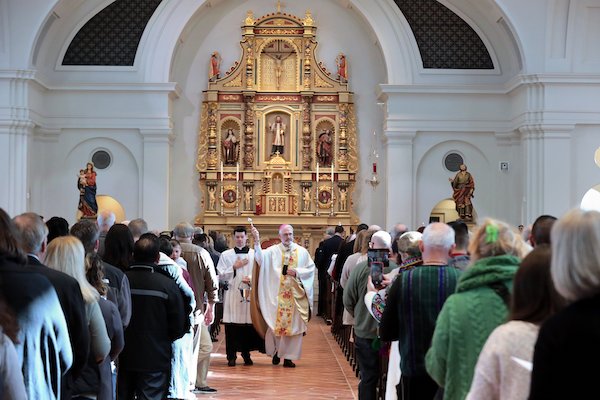
PROSPECT HEIGHTS — At the dedication of a shrine to honor Blessed Stanley Rother, the first martyr from the U.S. recognized by the Catholic Church, Archbishop Paul Coakley of Oklahoma City said Father Rother was an ordinary man with deep faith, who charted a path anybody can follow.
“If somebody from Okarche, Oklahoma, can be beatified, become a saint, then good golly, anybody can,” Archbishop Coakley said. “Because that’s the beauty of [Father Rother]. He was one of us, a very ordinary man, a hardworking man, a man of strong convictions, of deep faith, but not born with a halo.”
Archbishop Coakley presided over the Feb. 17 dedication of the $50 million shrine, which thousands attended. Among those in attendance were Archbishop Christopher Pierre, apostolic nuncio to the United States; Archbishop Emeritus Eusebius Beltran of Oklahoma City — whom Archbishop Coakley credited with pursuing Father Rother’s cause; and Archbishop Gonzalo de Villa of Santiago de Guatemala, formerly of the Diocese of Sololá-Chimaltenango, where Father Rother served and endured martyrdom.
While on mission work in Santiago Aititlán, Guatemala, in 1981, Father Rother was shot to death by three masked assassins who entered his rectory during the nation’s civil war, a bloody 36-year conflict which left an estimated 200,000 people killed or “disappeared.”
At the time, Father Rother was 46. Pope Francis recognized him as a martyr in 2016, and he was beatified a year later. In addition to being the first martyr, he was the first U.S.-born diocesan priest to be beatified.
Father Rother needs a verified miracle involving his intercession to become a saint.
At the dedication, Archbishop Coakley spoke about the example Father Rother set for all Catholics — clergy and laity — at a time when much of the country and world are becoming ever more hostile to the faith. He said the times call for “a certain measure of heroism and intentionality, a heroism that comes only from living out of a deep personal relationship with Jesus Christ.”
“The world into which we are sent to make disciples needs committed priests. It needs holy marriages and families,” Archbishop Coakley said. “It needs dedicated lay leaders in the professions … to renew the culture in the light of the Gospel, the fragrance of Christ, and the attractive beauty of holiness.”
“We need faithful witnesses and fervent missionary disciples,” the archbishop continued. “Let us learn. Let us study the example of our Blessed Brother Stanley Rother and confidently seek his intercession that we will be found faithful as he was faithful and ultimately be welcomed, as he was welcomed, into the company of the saints.”
Father Rother was born in 1935 in the small town of Okarche, Oklahoma, which is about 40 miles northwest of Oklahoma city. Growing up, he was an altar boy at his hometown Holy Trinity Catholic Church, but farming, not the priesthood, was more his expected path.
When Father Rother chose to pursue the priesthood, he struggled out of the gate. He dropped out of his first seminary, before graduating from another ahead of his ordination in 1963. Archbishop Coakley highlighted that Father Rother’s seminary struggles show the trust he put in the Lord “to use his considerable natural gifts and talents and to enhance them with spiritual gifts and charisms.”
“What an inspiration, an encouragement, for each of us to move beyond our own self, and [our] self-limiting comfort zones and fears,” Archbishop Coakley said. “To serve as we are needed, where we are needed, no matter the demands, no matter the costs. To be generous. Indeed, to be heroic if that is what’s called for.”
After Father Rother’s ordination, he served in several Oklahoma parishes before volunteering for mission work in Santiago Atitlán, Guatemala, in 1968. He spent 13 years in the Central American nation. About half a year before he was killed on July 28, 1981, Father Rother wrote in a 1980 Christmas letter home that “the shepherd cannot run at the first sign of danger,” and chose to remain in Guatemala.
The shrine in Father Rother’s honor, located in Oklahoma City, features a 2,000-seat sanctuary, a visitor center, and a gift shop. The “principal relic” of the shrine is Rother’s body, located in the adjoining chapel.
The shrine also features a re-creation of Tepeyac Hill, the Mexico City site where Catholics believe the Virgin Mary appeared to St. Juan Diego in December, 1531.
Archbishop Coakley called on those at the dedication to share Father Rother’s story, noting that “we can learn from Blessed Stanley’s life many important lessons.” He added that it’s especially important to encourage young men and seminarians, and pray for vocations to the priesthood, by offering the example of Father Rother.
“To spread his cult, as we call it in the church, to increase devotion to him and it shouldn’t be hard. The more we know about his life we find a very attractive figure, so relatable. A real every man, ordinary, just like us,” Archbishop Coakley said. “Not just for priests, but for all of us. But in a particular way for young men who dream about doing something impactful, I would dare say heroic, with their lives.”
